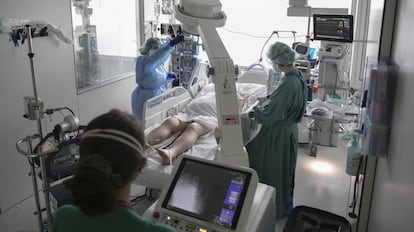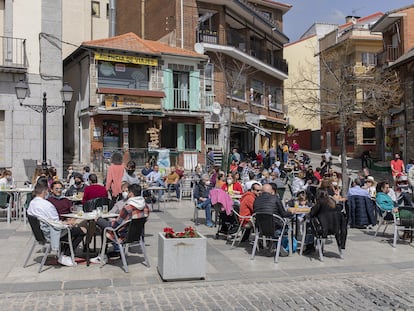Spain’s ICUs under mounting pressure as coronavirus cases rise: ‘The situation is very worrying’
With occupancy rates above 30% in some regions, experts warn any uptick in infections would put the country’s health system in danger once more

The pandemic is continuing to pile the pressure on Spain’s intensive care units (ICUs). The effect of the third wave is still being felt, with one in five ICU beds occupied by Covid-19 patients, and the threat of a fourth wave putting hospitals on alert. Any uptick in infections under these circumstances would put the country’s health system in danger once more.
“Between each wave, there isn’t enough time for deescalation, and each wave is catching us with more beds occupied by Covid patients,” complains Ricard Ferrer, the head of the UCI at the Hospital Vall d’Hebron in Barcelona and the president of the Spanish Society of Intensive Medicine.
While it seems like infections are falling, in the ICUs we have never been able to breathe easilyJosé Eugenio Guerrero, ICU chief at Madrid’s Gregorio Marañón Hospital
Madrid, Catalonia, La Rioja and Melilla currently have more than a third of their ICU beds occupied by Covid-19 patients. The Health Ministry’s alert system considers anywhere between 5% and 10% to be low risk.
The pandemic has forced hospitals to shore up their infrastructure for ICU beds and there are currently 10,000 spaces across the country – more than double the number before the pandemic hit. Hospitals are working like a kind of accordion at the moment, providing or removing beds according to demand. “Right now, in Catalonia, the beds that are occupied by Covid patients [more than 400] more or less correspond to those that we have increased during the pandemic, so they don’t affect non-Covid patients. But if they grow more, they will once again affect the surgical schedules,” Ferrer warns. According to the Health Ministry, there are 1,925 patients with Covid-19 in Spanish ICUs.
The incidence of new infections has been growing for some days now, coming in on Monday at 163 cases per 100,000 inhabitants over 14 days. This rise has already been reflected in ICU admissions, which are also going up – the figure has grown 4.45% since April 1. “The time patients spend in the ICU is very long,” explains José Eugenio Guerrero, ICU chief at Madrid’s Gregorio Marañón Hospital. “While it seems like infections are falling, in the ICUs we have never been able to breathe easily.”

The patients who are entering the ICUs are younger and are recovering well in general, but not any quicker. And the rhythm of admissions and discharges is not the same as the curve of new infections. “The incidence curve is progressing faster than that of the ICUs,” warns Daniel López-Acuña, a former director at the World Health Organization (WHO). “If there is a fourth wave, even if it’s smaller, we will have a cumulative effect.”
Alberto Lafuente, the manager of the health system in La Rioja, agrees. “The situation is very worrying because patients have been left in a chronic condition from the third wave and we are already seeing how the pressure on the system is starting to rise once more,” he says.
If the ICUs fill up again, consults, tests and surgeries will be put on holdAlberto Lafuente, manager of the health system in La Rioja
With 35.8% of ICU beds occupied by Covid patients, La Rioja is one of the worst-affected regions in this respect. During the peak of ICU admissions during the third wave, on February 1, 45.3% of ICU beds in Spain were occupied by Covid patients – nearly 4,900 people. But in La Rioja, the figure was as high as 71%. “We have a smaller healthcare system and we don’t have the flexibility of other regions, so we had to improvise,” explains Lafuente. In Madrid, the current ICU occupation rate by Covid patients is 37%, while in Catalonia it is 35% and in the North African city of Melilla, it is 41%.
Spain’s ICUs were used to working with high occupation rates, but their resources were limited and the flood of patients during the first wave overwhelmed the system – hospitals had to halt all other activity, suspending surgeries and other activity and assigning most of the ICU beds to the most serious Covid patients.
During the second and third waves, hospitals had to find a way to combine coronavirus treatment and normal activity, but also had to suspend the latter at times. Lafuente insists that the challenge this time will be “to try not to stop the system.” He continues: “If the ICUs fill up again, we will have to turn to professionals from other areas and consults, tests and surgeries will be put on hold.”
The experts consulted by EL PAÍS are predicting a “flatter” fourth wave compared to the previous ones, but they are counting on ICUs suffering once more and warn that staff are “exhausted.” “I think that a dramatic fourth wave is unnecessary,” says Ferrer. “We know how to stop it, so let’s not be in a hurry to deescalate [coronavirus restrictions].”
English version by Simon Hunter.
Tu suscripción se está usando en otro dispositivo
¿Quieres añadir otro usuario a tu suscripción?
Si continúas leyendo en este dispositivo, no se podrá leer en el otro.
FlechaTu suscripción se está usando en otro dispositivo y solo puedes acceder a EL PAÍS desde un dispositivo a la vez.
Si quieres compartir tu cuenta, cambia tu suscripción a la modalidad Premium, así podrás añadir otro usuario. Cada uno accederá con su propia cuenta de email, lo que os permitirá personalizar vuestra experiencia en EL PAÍS.
¿Tienes una suscripción de empresa? Accede aquí para contratar más cuentas.
En el caso de no saber quién está usando tu cuenta, te recomendamos cambiar tu contraseña aquí.
Si decides continuar compartiendo tu cuenta, este mensaje se mostrará en tu dispositivo y en el de la otra persona que está usando tu cuenta de forma indefinida, afectando a tu experiencia de lectura. Puedes consultar aquí los términos y condiciones de la suscripción digital.
More information
Últimas noticias
Maduro pleads not guilty before the federal court in New York: ‘I am still the president of Venezuela’
A new test can detect Alzheimer’s from a finger prick
UN team enters Sudanese city of El Fasher after paramilitary massacre: ‘It’s like a ghost town’
A recipe for resistance: Indigenous peoples politicize their struggles from the kitchen
Most viewed
- Gilles Lipovetsky: ‘If you want to live better and fall in love, take Prozac, don’t look to philosophy’
- Alain Aspect, Nobel laureate in physics: ‘Einstein was so smart that he would have had to recognize quantum entanglement’
- Alvin Hellerstein, a 92-year-old judge appointed by Bill Clinton, to preside over Maduro’s trial in New York
- Maduro’s downfall puts China’s relationship with Venezuela to the test
- Why oil has been at the center of Venezuela-US conflicts for decades









































